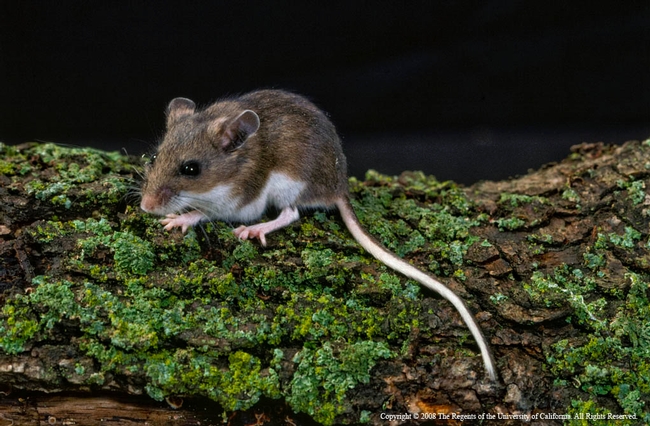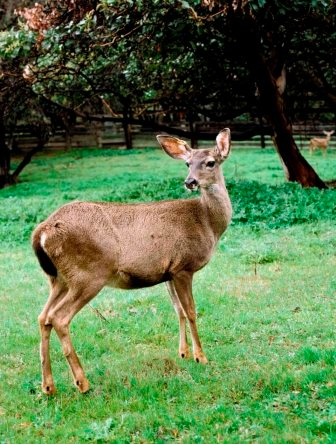
Posts Tagged: deer
Deer-Resistant Plants: Truth or Fiction?
[From the October 2013 issue of the UC IPM Retail Nursery & Garden Center News] Is there such...
Recent cases of hantavirus a reminder to be mindful of deer mice

Hantavirus is a very rare but very serious disease. About one-third of cases identified in California are fatal, CDPH reports. Since hantavirus was first identified in 1993, there have been 60 cases in California and 587 cases nationally. The two recent cases bring the total California case count for 2012 to four.
Hantaviruses are a group of viruses spread mainly by deer mice. The UC Integrated Pest Management Program recently published a comprehensive online Pest Note about deer mice, which details identification, biology and behavior, damage and management. The publication says deer mice are the most abundant and widely distributed mammal in North America. Proficient jumpers and runners, deer mice were so named for their agility.
Because deer mice prefer forests, grasslands and agricultural crops, they aren’t normally found in urban and residential areas unless fields, forests or other suitable habitats are close by. Deer mice shed the hantavirus in their saliva, urine and droppings. A person may be exposed to hantavirus by breathing contaminated dust after disturbing or cleaning rodent droppings or nests or by living or working in rodent-infested settings. There is no evidence that North American hantaviruses can spread from one person to another.
The most effective way to avoid contracting hantavirus from deer mice is to keep them out of houses, cabins, and dwellings by rodent-proofing and excluding them from these structures by sealing all small gaps and cracks. Once deer mice infest a dwelling, it is critical to avoid working and sleeping in these areas until the infestation has been controlled and the area has been made safe for humans.
Before occupying an infested building, open the doors and windows to air out the room for at least 30 minutes. Where possible, use an electric fan on windowsills and in door entrances to assist the process. Be sure to vacate the building during the ventilation process to prevent inhaling aerosolized particles. Wearing a commercially available cloth or paper breathing mask offers some protection and is better than no protection at all. However, only an approved respirator equipped with high-efficiency particulate air (HEPA) filters offers total respiratory protection against airborne viruses.
It is important to wear nonfabric gloves (e.g., rubber, latex, vinyl, or nitrile) when cleaning deer mouse-infested buildings. Because humans can contract the virus by inhaling aerosolized deer mouse urine and feces, never stir up dust by vacuuming or sweeping or through any other activity.
To disinfect potentially contaminated areas, thoroughly wet trapped deer mice, droppings, and nests with an appropriate disinfectant solution such as Lysol or a 10% hypochlorite (bleach) solution. To make this bleach solution, mix 1 1/2 cups of household bleach in 1 gallon of water (or one part bleach to nine parts water). Note that a bleach solution may damage rugs and fabrics and irritate skin. Wear nonfabric gloves whenever touching or cleaning contaminated surfaces or when handling mouse nests, dead mice, or mouse traps.
Once everything has soaked for 10 minutes, remove all nest material, mice and droppings with a damp towel and then mop or sponge the area with the disinfectant solution. Upholstered furniture and carpets can be shampooed and steam cleaned. If you wish to reuse the gloves used while cleaning contaminated areas, you must properly disinfect them before removal. After removing the gloves, it is important to thoroughly wash hands with soap and water or use a waterless alcohol-based hand sanitizer when soap is unavailable and hands aren’t visibly soiled.
The UC IPM Pest Note on deer mice was written by Niamh Quinn, Evolution, Ecology, and Behavior, University of Liverpool, Liverpool, U.K., niamh.quinn@liverpool.ac.uk; Roger Baldwin, UC Cooperative Extension advisor, Statewide IPM Program, Kearney Agricultural Research and Extension Center, Parlier; and Bob Timm, director, UC Hopland Research and Extension Center,. For additional up-to-date information on rodent cleanup, visit the Centers for Disease Control and Prevention Web site, http://www.cdc.gov/rodents/cleaning/index.html.
Reducing roadkill on freeways

UC Davis researchers and state Department of Fish and Game officials are capturing deer between Dec. 2 and Dec. 15 along a stretch of the freeway from Millbrae to Woodside, said Fraser Shilling (video clip), head of the research project and co-director of the Road Ecology Center at UC Davis.
Using tranquilizer darts fired from a rifle, or "clover traps" (large netting enclosures), about 15 deer are expected to be captured. Researchers plan to capture another 30 deer by the time the project is completed in May 2013.
The deer would be "minimally disturbed" by the darts or enclosures, with the worst harm being from falling down, according to Shilling.
"That's the level of harm," he said. "There's no long-term damage to it."
The captured deer will be fitted with GPS collars that will record their location and send the information to researchers who will use the data to track the deer as they move along the areas adjoining the freeway, or onto the roadway itself.
Timers will automatically release the collars after six months, Shilling said.
Besides tracking the deer, researchers will also use 40 wildlife cameras to capture images of wildlife and map the locations of road kill. The information will be used to make a recommendation to determine what kind of strategies could be used to reduce the number of collisions between deer and other animals on the freeway.
Deer grazing along the side of the freeway and dead deer on the shoulder are common sights along the roadway, which runs through mostly heavily-wooded areas, rolling hills, and grasslands between San Francisco and San Jose.
The deer study, funded by a $320,000 grant through the federal Transportation Enhancement program, will be used to try to reduce the number of collisions between cars and deer on the freeway.
Every year, about 300,000 collisions occur nationwide between vehicles and wildlife, resulting in 200 deaths and 26,000 injuries. The costs associated with deer strikes alone add up to $8.5 billion annually.
Road Ecology Center at UC Davis
“Road ecology” is emerging as an environmental science focusing on the impact of roads on nature, such as how plant and animal populations are fragmented by roads, and how vehicle noise and pollution negatively impact animals and plants.
An understanding of road ecology also allows transportation planners to optimize mobility while minimizing the adverse impact of roads and vehicles.
The UC Davis Road Ecology Center brings together policy makers from transportation and environmental settings to design sustainable transportation systems that complement the needs of natural landscapes and human communities.
Some of the organizations partnering with the Road Ecology Center on projects include Caltrans, the California Department of Fish and Game, the UC Davis Sustainable Transportation Center, the John Muir Institute of the Environment and the Institute of Transportation Studies at UC Davis, and Defenders of Wildlife.
Citizen science
A “citizen science” component of the Road Ecology Center is the California Roadkill Observation System, a statewide roadkill reporting website for people to record their observations of dead animals and their environmental context. The information will be used to reduce the number of roadkill incidents.
The top 5 species of animals killed on California roads and highways are raccoon, striped skunk, California ground squirrel, Virginia opossum, and mule deer (or black-tailed deer).
